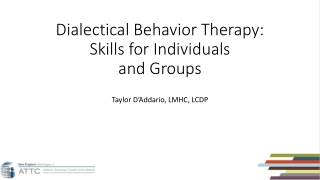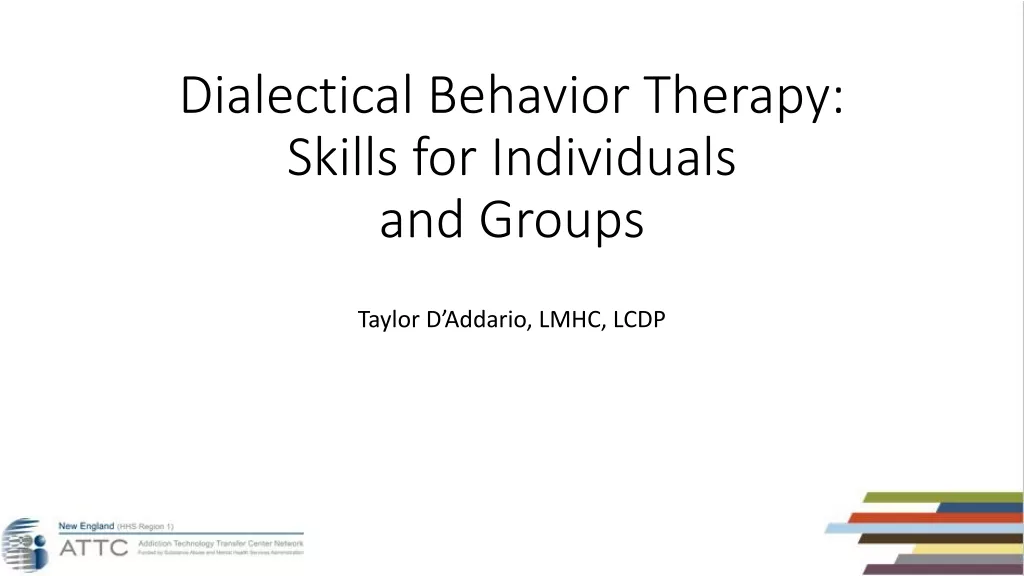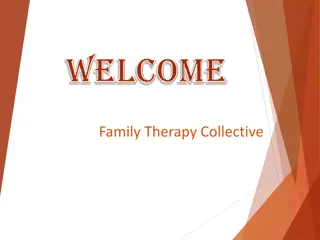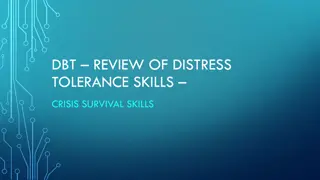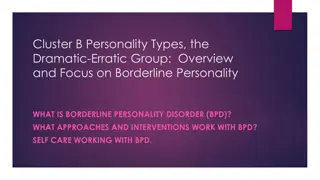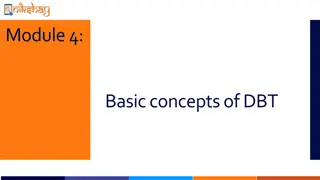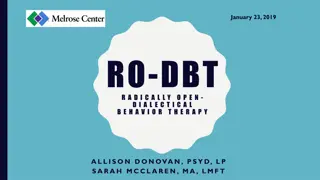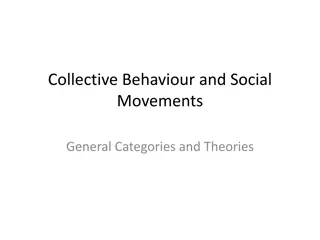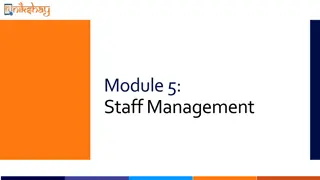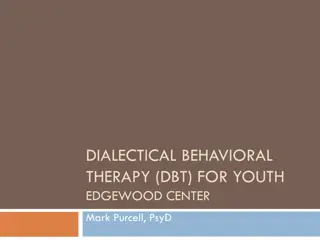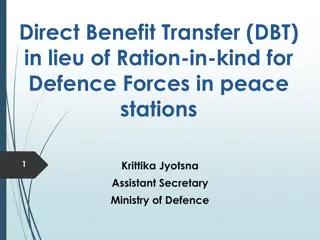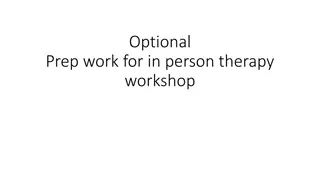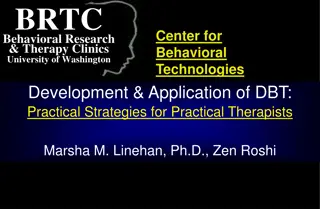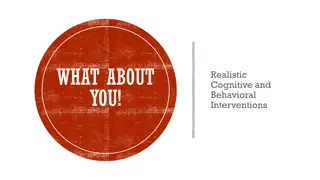Understanding Dialectical Behaviour Therapy (DBT)
Dialectical Behaviour Therapy (DBT) is a comprehensive cognitive-behavioural treatment developed by Dr. Marsha Linehan to help individuals with chronic suicidal tendencies and Borderline Personality Disorder. DBT focuses on validation, dialectics, and treatment hierarchy to address dysregulation and promote emotional well-being. It has been proven effective in reducing suicidality, parasuicidal behavior, treatment dropout, hospitalizations, and various emotional issues. DBT offers core treatment strategies, including distress tolerance, emotion regulation, interpersonal effectiveness, and mindfulness. Adaptations of DBT cater to various populations, including adolescents, individuals with substance use issues, and those with bipolar disorder. A typical DBT program consists of individual therapy, weekly skills training groups, phone coaching, and therapist consultation.
Download Presentation

Please find below an Image/Link to download the presentation.
The content on the website is provided AS IS for your information and personal use only. It may not be sold, licensed, or shared on other websites without obtaining consent from the author. Download presentation by click this link. If you encounter any issues during the download, it is possible that the publisher has removed the file from their server.
E N D
Presentation Transcript
A Brief Introduction to Dialectical Behaviour Therapy Dr. Nathalie Lovasz, C.Psych (Supervised Practice) Head of Adult DBT Program The Mindfulness Clinic Dr. Andrew Spice, C.Psych (Supervised Practice) Head of Adolescent DBT Program The Mindfulness Clinic
Agenda Overview of DBT Definition, development, research, adaptations Section 1: Assessment and Case Conceptualization Areas of Dysregulation: Signs that DBT may be helpful Theoretical model Stages of treatment; organizing treatment targets hierarchically Section 2: Treatment Core treatment strategies: Validation and chain analysis DBT Skills Distress Tolerance Emotion Regulation Interpersonal Effectiveness Mindfulness Section 3: Additional Issues in DBT DBT and Other Professionals Recommended Readings Further Training
What is DBT? Comprehensive cognitive-behavioural treatment Developed by Dr. Marsha Linehan at University of Washington Originally developed to treat chronically suicidal clients diagnosed with Borderline Personality Disorder Found to be effective for suicidal clients with multiple other co-occurring behavioural problems
Development of DBT CBT did not work for clients with chronic suicidality and BPD Change focus was invalidating Clients unintentionally reinforced therapists for behaviours that were not helpful and punished/extinguished helpful behaviours Unrelenting crisis interfered with treatment/skills acquisition Solutions: Validation, Dialectics, Treatment Hierarchy, Multi-modal treatment
Research Findings DBT has been found to reduce Suicidality Parasuicidal behavior Treatment drop-out Hospitalizations Substance Use Depression, Hopelessness, Anger (Linehan et al., 1991;1999; Koons et al., 2001, Verheul et al., 2003)
Adaptations of DBT Substance Use Adolescents/Children Binge Eating Bipolar Disorder Couples Inpatient
Components of a DBT Program 1. 2. 3. 4. Individual (DBT) Therapy Weekly Skills Training Group Phone Coaching Therapist Consultation Team DBT-informed Therapy: - Any treatment that does not include ALL FOUR of the above components - E.g. CBT therapy that incorporates some DBT skills - Group only Skills Training - Skills Group + Individual Therapy without Phone Coaching - Skills Group, Individual Therapy, Phone Coaching but no consultation team
Assessment and Case Conceptualization
Symptoms of Borderline Personality Disorder Emotion Dysregulation Unstable Emotions/Mood Intense Anger/Difficulty Controlling Anger Interpersonal Dysregulation Unstable/Intense Relationships Frantic Efforts to Avoid Abandonment Behavioural Dysregulation Impulsive/Self-Damaging Behaviours Suicide/Self-harm Identity/Self Dysregulation Unstable Sense of Self/Identity Feelings of Emptiness Cognitive Dysregulation Stress Related Paranoid Thoughts Dissociation
Practice 1 Identify Areas of Dysregulation in a Practice Case Choose one of the two case vignettes provided. Identify as many areas of dysregulation as possible in the case vignette: Emotion Interpersonal Cognitive Behavioural Identity/Self
Biosocial Model of BPD EMOTIONAL VULNERABILITY Emotional Sensitivity: More easily triggered emotions Responding with intense emotions to things that may not cause any emotion for someone else Thinner emotional skin Emotional Reactivity: More intense emotions Higher emotional baseline Slow Return to Baseline: Emotions that stick around longer
Biosocial Model of BPD INVALIDATION Emotional Fit: It can be difficult for people with less intense emotions to understand or teach those with more intense emotions how to manage their emotions Denial/Suppression of Emotions: With more intense emotions, people either doubt and ignore their emotions until they explode or become more intense in emotional expressions Reciprocal Effects: Emotions that are more intense than average are more likely to be dismissed by others Absence/Abuse/Neglect: These can also teach people to ignore, doubt, or push away emotions
Biosocial Model of BPD EMOTIONAL VULNERABILITY + INVALIDATION = BORDERLINE PERSONALITY DISORDER
Practice 2 Apply the Biosocial Model to a Practice Case Choose one of the vignettes provided. Identify any information you have that applies to the Biosocial Model: Emotional Vulnerability Experiences of Invalidation
Stages of Treatment Stage I: Stabilization Focus: Treatment Hierarchy: Reduce Life-Threatening Behaviours Reduce Therapy-Interfering Behaviours Reduce Quality-of-Life-Interfering Behaviours Increase Skills that Replace Ineffective Coping Goal: Move from behavioural dyscontrol to control to achieve a normal life expectancy
Target Hierarchy in Stage I 1. Life-Threatening Behaviours Suicide NSSI 2. Therapy-Interfering Behaviours E.g. Missing sessions, not completing homework, behaviours that interfere with therapist s motivation to treat client 3. Quality-of-Life-Interfering Behaviours E.g. Substance use, eating disordered behaviours, inability to keep employment, educational Issues 4. Skills Acquisition To replace dysfunctional behaviours
Stages of Treatment Stage II: Suffering in Silence Focus: Address inhibited emotional experiencing Reduce PTSD symptoms Goal: Move from quiet desperation to full emotional experiencing
Stages of Treatment Stage III: Build a Life Worth Living Focus: Problems in Living Goal: Life of ordinary Happiness and Unhappiness Stage IV: Address Issues of Meaning (Optional) Focus: Spiritual Fulfilment Connectedness to Greater Whole Goal: Move from incompleteness to ongoing capacity for Experiences of Joy and Freedom
Practice 3 Identify stages of treatment and applicability of the treatment hierarchy to a practice case 1. Choose one of the provided case vignettes. List any therapy goals you and the client might choose to work on 2. Identify at what stage of treatment you would work on each of these goals 3. For Stage I Goals, create a treatment hierarchy: Life-Threatening Behaviours Therapy-Interfering Behaviours Quality-of-Life Interfering Behaviours Skills Acquisition
Core DBT Strategies Validation and problem-solving form the core of DBT All other strategies built around them Problem-solving strategies are change-based Analyzing behaviour, committing to change, taking steps to change Validation strategies are acceptance-based Engaging client in understanding actions, emotions, and thoughts
Core DBT Strategies: Validation VALIDATION MEANS: Communicating to the client that their responses make sense and are understandable within current life context Finding the kernel of truth in the client s perspective or situation Acknowledging causes of emotions, thoughts, and behaviours
Core DBT Strategies: Validation IMPORTANT THINGS TO VALIDATE: Emotions: Feelings, wanting, suffering, difficulties Thoughts: Beliefs, opinions, or thoughts Actions Abilities REMEMBER: Every invalid response makes sense in some way Validation is not necessarily agreeing Validation doesn t mean you like it Only validate the valid
A How To Guide to Validation PAY ATTENTION: Listen actively with body and mind. REFLECT BACK: Say back what you heard descriptively and non-judgmentally. READ MINDS: Be sensitive to what is not being said by the client. Be open to correction. UNDERSTAND: Look for how the client s emotions, thoughts, and actions make sense given their history, state of mind, or current situation, even if you don t approve of the behaviour, emotion, or action itself.
A How To Guide to Validation ACKNOWLEDGE THE VALID: Show you are taking the client seriously by what you say and do SHOW EQUALITY: Be yourself! Treat the client as an equal, not as fragile or incompetent
Practice 4 Practice validation 1. Get into pairs 2. One person will be the storyteller, one person will be the validator 3. The storyteller tells a story of something that recently happened to them and that elicited some emotion 4. The validator listens and responds only with validation 5. Switch roles
Core DBT Strategies: Chain Analysis Core problem-solving strategy Purpose: examine events and situational factors leading up to and following a problematic response
Steps of a Chain Analysis 1. Choose a specific instance of behavior to analyze 2. Describe the behavior specifically Topography ( What exactly did you do? ; What exactly do you mean by that? ) Frequency ( How many times did you do that? ) Intensity ( How intense was the feeling on a 1-100 scale? )
Steps of a Chain Analysis 3. Determine antecedents Link client s behavior to environmental events Internal and external events Ask when the problem began What set that off? What was going on the moment the problem started? Fill in links in terms of small units of behavior Doing, feeling, thinking, imagining Once one link is described, determine the next What next? How did you get from feeling like you wanted to talk to me to calling me on the phone?
Steps of a Chain Analysis 4. Determine consequences Those influencing problem behaviour by maintaining, strengthening, or increasing it E.g., preferable events, stopping of aversive events, opportunities to engage in preferable behaviours Assess external and internal events 5. Determine function of the behaviour
Sample Chain Analysis Behaviour: Overdose (with suicidal intent) Thought: I can t live without him Thought: He will leave me Event: Fight with boyfriend Vulnerability: Intoxicated Emotion: Panic Thought: Will be better if I m dead Action: Walk to bathroom and get pills Urge: Take pills to forget Emotion: Despair Action: Take pills Event: Boyfriend visits in hospital Event: Picked up by EMS Emotion: Love and affection
DBT Behavioral Chain Analysis Worksheet Name: _______________ Date: ______ Target Behavior: _________________________ Types of Links: A Actions B Body Sensations C Cognitions E Events F Feelings Chain Analysis: Solution Analysis: Things in myself and my environment that made me vulnerable: Ways to reduce vulnerability in the future: Vulnerability Factors Prompting Event: Ways to prevent prompting event in future: E Actual Behaviors and Events: Skillful alternative behaviors: Problem Behavior Consequences and Harm (Immediate and delayed) Consequences in the environment? Plans to repair, correct, and over-correct harm: Consequences in myself? Adapted from Marsha Linehan s Chain Analysis Worksheet by Seth Axelrod, PhD 2/13/04
Practice 5 Practice chain analysis using a practice case 1. Get into pairs 2. Choose one of the two vignettes provided 3. One person will role play the client, one person will role play the counsellor 4. Choose a specific behaviour from the case vignette to chain analyze e.g., cutting, waiting for faculty member in the parking lot 5. Role play a chain analysis of this behaviour. The counsellor will have to ask as many questions as needed to fill in the links of the chain
DBT Skills Distress Tolerance Emotion Regulation Interpersonal Effectiveness Mindfulness
Distress Tolerance How to get through a crisis without making things worse
Distress Tolerance: Crisis Survival Skills CRISIS SURVIVAL SKILLS are needed: When client is in a situation that is Highly stressful Short-term Creating intense pressure to resolve the crisis now AND Acting on emotions and urges will make things worse Client cannot make things better right away Client must temporarily tolerate painful events and emotions CRISIS SURVIVAL SKILLS are not for: Everyday use Solving all of life s problems Making life worth living
STOP Skills Stop Do not just react. Stop! Freeze! Do not move a muscle! Your emotions may try to make you act without thinking. Stay in control! Take a step back Take a step back from the situation. Get unstuck from what is going on. Let go. Take a deep breath. Do not let your feelings put you over the edge and make you act impulsively. Observe Take notice of what is going on inside and outside of yourself. What is the situation? What are your thoughts and feelings? What are others saying or doing? Proceed mindfully Act with awareness. In deciding what to do, consider your thoughts and feelings, the situation, and the thoughts and feelings of other people. Think about your goals. What do you want to get from this situation? Which actions will make it better or worse?
TIPP Skills TIP YOUR TEMPERATURE INTENSELY EXERCISE PACE YOUR BREATHING PROGRESSIVELY RELAX YOUR MUSCLES
TIPP Skills Tip the TEMPERATURE of your face: use ice water to calm yourself down fast by changing the response of your autonomic nervous system Put your face in a bowl of ICE WATER (30 seconds) OR splash ICE WATER on your face, OR hold a gel ICE pack (or zip-lock ICE WATER) on your face. INTENSELY EXERCISE to calm down a body revved up by emotion Engage in intense exercise, if only for a short while. Expend your body s stored up physical energy by: Running, Walking , Fast Jumping, Playing Basketball, Weight Lifting, etc.
TIPP Skills PACE YOUR BREATHING BY SLOWING IT DOWN Slow your pace of inhaling and exhaling way down (on average 5 to 7 breath cycles per minute). Breathe deeply from the abdomen. Breathe more slowly out than when breathing in (for example, 4 seconds in and 8 seconds out). PROGRESSIVELY RELAX YOUR MUSCLES Starting with your hands, moving to your forearms, upper arms, shoulders, neck, forehead, eyes, cheeks & lips, tongue & jaw, chest, upper back, stomach, buttocks, thighs, calves, ankles, feet. TENSE (5 seconds), then let go and RELAX each muscle (all the way). NOTICE the tension. NOTICE the difference when relaxed.
Pros and Cons Use PROS and CONS anytime you have to decide between two courses of action. Pros Cons Acting on Crisis Urges Resisting Crisis Urges
Distraction A way to remember these skills is the acronym ACCEPTS Activities: Refocus your attention on the task you have to get done TV, events, exercise, internet, sports, hobbies Contributing: Volunteering, help a friend, encourage someone Comparisons: Compare how you are feeling now to a time when you felt different Different Emotions: Books, stories, movies, music Pushing Away: Leave the situation; block thoughts from your mind OtherThoughts: Counting; puzzles OtherSensations: Squeeze a rubber ball; hold ice; go out in the rain
Self-Soothing A way to remember these skills is to think of soothing each of your FIVE SENSES: Vision: Stars at night; pictures in a book, nature, candles Hearing: Soothing music; invigorating music; sounds of nature; sounds of the city Smell: Soap, incense, coffee, essential oils, boil cinnamon Taste: Favourite foods; soothing drinks; chew gum Touch: Hot baths; pet your dog or cat; creamy lotion; comfortable clothing
Group Discussion 1 Discuss how Distress Tolerance skills may be helpful to our practice cases At your table, choose one case vignette. 1. How could these distress tolerance skills help the client in the vignettes accomplish their treatment goals? 2. How would you teach these skills to a client?
Emotion Regulation How to understand emotions, change ineffective emotions, and be less vulnerable to negative emotions
Emotion Encyclopedia Related Emotion Words Basic Emotion Anger Disgust Aggravation, agitation, annoyance, bitterness, exasperation, ferocity, frustration, fury Abhorrence, antipathy, aversion, condescension, contempt, dislike, derision, disdain, distaste, hate, Bitterness, covetous, craving, discontented, disgruntled, displeased, dissatisfied, down- hearted Envy Fear Happiness Anxiety, apprehension, dread, edginess, fright, horror, hysteria, jumpiness, nervousness Joy, enjoyment, relief, amusement, enthrallment, hope, satisfaction, bliss, enthusiasm, jolliness Cautious, clinging, clutching, defensive, fear of losing someone or something, mistrustful Jealousy Adoration, affection, arousal, attraction, caring, charmed, compassion, desire, enchantment Love Despair, grief, misery, agony, disappointment, homesickness, neglect, alienation, discontentment, pity, anguish, dismay, hurt, rejection, crushed, displeasure, insecurity, sorrow, defeat Sadness Contrition, culpability, discomposure, embarrassment, humiliation, mortification, self- conscious, shyness Shame Guilt Apologetic, culpability, regret, remorse, sorry
Model of Emotion: Observe and Describe Emotions Prompting Event What set off the emotion? Emotion i.e., anger, fear, joy Interpretations Thoughts, judgments, beliefs Experiencing Body changes Action Urges e.g., withdraw, attack, eat Expressing Behaviours what you said or did Aftereffects Consequences your state of mind; others reactions; reinforcements
Opposite Action Changing ineffective emotions by ACTING OPPOSITE to the emotion Fear Urge: Freeze, run, avoid Opposite action: Approach Anger Urge: Attack, hit, yell Opposite action: Gently avoid; do something nice Sadness Urge: Withdraw, cry, isolate Opposite action: Get active Guilt/Shame Urge: Hide/avoid Opposite action: Face the music; repair mistakes
Group Discussion 2 Discuss how Emotion Regulation skills may be helpful to our practice cases At your table, choose one case vignette. 1. How could these emotion regulation skills help the client in the vignettes accomplish their treatment goals? 2. How would you teach these skills to a client?
Interpersonal Effectiveness How to get your needs met while maintaining your relationships and self- respect


